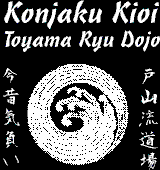|
Home
Hataya
Sensei DVD
Search
Bushido
Respect for Katana
Sword Dictionary
How to Guides
Bow In Ceremony
Warm Up Exercises
Bow Out Ceremony
Wearing Uniform
Formal Uniform
Wearing Daisho
Uniform Folding/Care
Katana Selection
Sword Dimensions
Sword Testing
Katana Maintenance
Katana Cleaning
Mekugi Replacement
Katana Disassembly
Is my sword sharp?
Edge Geometry
Surface Polish
Sharpening Guide
Training Basics
Kihon (Fundamentals)
8 Basic Cuts
Toyama Kata
Toyama Kukmitachi
Seitei Kata
Taikai Guides
Taikai Rules
Judging Guide
Tameshigiri
Target Prep & Spiking
Cutting Patters
Cutting Videos
Target Comparison
St Petersburg Dojo
Intro Letter
Femal Sensei
Dojo Members
Code of Conduct
Classes and Fees
Promotion Pictues
Rank Testing
Links

|
Putting on a Practice Uniform

There are three garments used for everyday sword practice. These are
the keikogi (practice top), obi (belt), and hakama (pleated pants). These
must be put on properly and the details may change based on the style of
swordsmanship practiced. The following defines the proper way they should
be worn in the Konjaku Kioi
Toyama Ryu Dojo. Unranked students should have blue keikogi and hakama.
Ranked students may wear black keikogi and hakama. Obi may be any color.
Students who are sandan and above should also have formal uniforms. Tabi
may also be worn during practice.
The keikogi is put on first. It is important to have the two sides even
and wrap it tightly around the body.



- The sides are grasped at the waist and pulled forward making sure the
two sides are even.
- The right side is wrapped around the waist followed by the left side.
- The keikogi is held in place with the right hand while the left is
used to wrap the obi around the waist. Any straps should be tied after
putting the obi on.
Most men wear the obi just under the hipbones while most women wear the obi
above the hipbones. A kaku obi (3.5 inch wide traditional obi) is recommended.
The obi must be tight enough to keep the katana in place but not too tight to
make saya biki (drawing saya back off of the katana) difficult.
- The first foot of the obi is folded over with the open side oriented
downward.
- The top of the folded section of the obi is aligned with the top of
the obi as it is wrapped around the waist three times


- The remaining section of obi is folded over with the open side
upward.


- The starting end of the obi is pulled out, wrapped around the
remaining section, and pulled tight.


- The remaining section of the obi is rolled up into a 6-inch long
section and centered on the knot.
- The starting section of the obi is wrapped over the top of the
folded section and threaded under the obi around the waist.


- The knot is then rotated clock-wise around the body to the back and
the loose tail is tucked in under the obi.


Problems:
- A standard iaido obi may be too thin and can be tied without
folding in steps 1 and 3.
- If your obi is too short only wrap it around the waist two
times in step 2.
The hakama should just touch the top of the feet. Himo (straps)
should be snug and their placement is important. Having a properly tied
obi knot in the back and keeping the rear himo tight will keep the koshi-ita
(rigid board section) in the right place.
- The front of the hakama is aligned with the top of the obi.
- The front straps are wrapped around the body and are aligned along
the top of the obi.
- The straps cross over the top of the knot in the obi and return to
the front at the bottom of the obi.


- The strap coming from the right side is wrapped over the strap from
the left side over the front of the left hip.
- The straps should be long enough to return to the back and tie below
the obi. These can be tied with a square knot or bow.




- The koshi-ita (rigid board section) of the hakama is worn above the
knot in the obi. If a tab is present, it is put under the obi to keep
the rigid section in place.


- The rear straps are wrapped around the body and slipped under the
front straps. They should cross below the front straps with the strap
going to the right below the strap going to the left.
- The strap going to the right is wrapped over and then around all the
straps in the center. It should now be hanging down in the center of
the hakama.


- The strap going to the left is folded over and the strap going down
is wrapped around all the straps a second time.


- The strap going to the left is rolled into a three-inch long section
and positioned in the center.
- The strap going down is then wrapped around this section and all the
straps.


- This strap is then wrapped around once more, but the end is left
hanging out of the top. The bottom loop should be about 1.5 inches
long.
- The top is then tucked in creating a loop matching the length of the
bottom loop.


Problems:
- If the front straps are not long enough for step 5 they must
be tied in the front with a square knot. The excess straps
should be wrapped around the tied strap.
|































